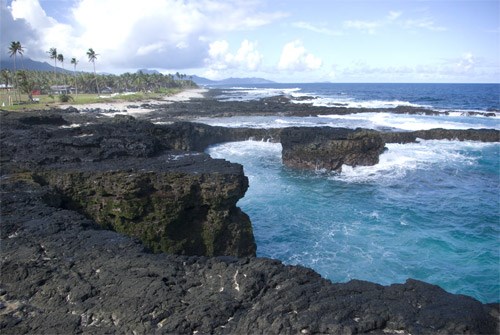Part of a series of articles titled Finding a Path Forward: Asian American Pacific Islander National Historic Landmarks Theme Study.
Article
Essay 12: Pacific Islanders in the US and their Heritage: Making Visible the Visibly Absent

Photo by Robert A. Pacheco, National Register of Historic Places.
The Pacific Ocean region includes 27 island nations and territories, each of which has at least one in two indigenous cultural groups. Hundreds of distinct indigenous peoples live in larger islands/island continents, such as New Guinea and Australia. Several of these Pacific Island areas are part of the United States in one fashion or another -- the unincorporated territories of American Samoa and Guam, the Commonwealth of the Northern Mariana Islands,[2] and the state of Hawai'i. Indigenous Taotao Haya (Chamorro),[3] Refaluwasch (Carolinian), and Kanaka Maoli (Native Hawaiian) Pacific Islander Americans and Tagata Samoa (Samoan) Pacific Islander American nationals are present both in their homeland islands as well as throughout the rest of the US.[4] The US has also claimed eight other Pacific Islands and island groups that are essentially uninhabited except for certain military or other government-related worker or scientific data-gathering populations.[5]
Additionally, three independent Pacific Island nations -- the Republic of Palau, The Federated States of Micronesia, and the Republic of the Marshall Islands -- are Freely Associated States in treaty relationshps with the US. Pacific Islanders of Palau, Yap, Chuuk, Pohnpei, Kosrae,[6] and the Marshalls, in relatively large numbers, serve in the US military, live within parts of the US, and are, at times, Pacific Islander Americans in addition to being citizens of their island nations.[7] Read more >> (.pdf 3.1MB)
[1] Altough effort has been made to discuss US Pacific Islander peoples collectively and individually, the authors specialize in studying Guam history and issues, as reflected in this essay.
[2] Often referred to as CNMI.
[3] Taotao Tano' (People of the land) is another indigenous term used to refer to Chamorros.
[4] This includes having presence in each other's islands as well.
[5] Sometimes referred to as US Minor Islands, these are Baker island, Howland Island, Jarvis Island, Johnston Atoll, Kingman Reef, Midway Atoll, Navassa Island, Palmyra Atoll, and Wake Island. Palmyra Atoll is the only incorporated territory in the US. At least one of these areas, Wake Island, or Eneen Kio in Marshallese, is also claimed by the Republic of the Marshall Islands as Marshallese voyaged to and used the island traditionally. The Marshall Islands is said to have put its claim to the island on record at the United Nations. See Johnson 2016.
[6] The island areas of Yap, Chuuk, Pohnpei, and Kosrae, each comprised of numerous islands, are states within the Federated States of Micronesia. One or more culture groups is recognized per island state. For example, for what are referred to as Yap's Outer Islands, the many culture groups there are often generally referred to as Carolinian or Remathau (People of the Sea), while the culture group in the main island of Yap is referred to as Girdi nu Wa'ab (People of Yap).
[7] For a brief overview on the Pacific Islands as a geocultural region and their environments and histories, see Smith and Jones 2007, 17-30.
The views and conclusions contained in the essays are those of the authors and should not be interpreted as representing the opinions or policies of the U.S. Government. Mention of trade names or commercial products does not constitute their endorsement by the U.S. Government.
Tags
- aapi theme study
- pacific islander history
- pacific islanders
- asian american and pacific islander heritage
- asian american and pacific islander history
- hawaii
- american samoa
- guam
- chamorro
- samoan
- northern mariana islands
- republic of palau
- federated states of micronesia
- republic of the marshall islands
- immigration
- colonialism
- political history
- transportation history
- labor history
- aboriginal history
- historic preservation
Last updated: July 23, 2024
